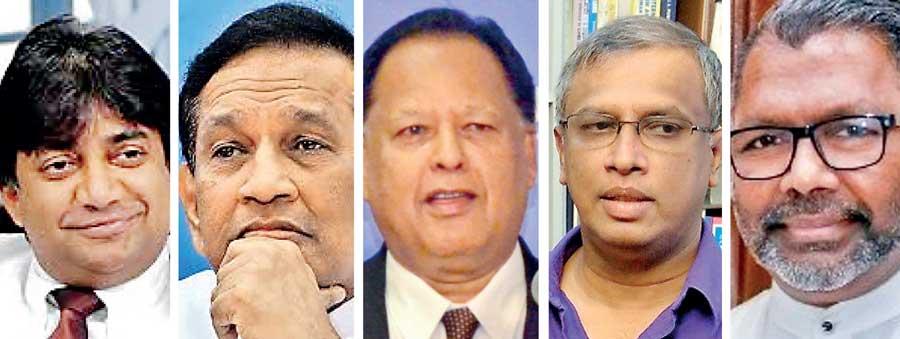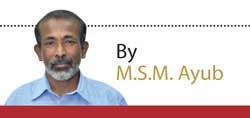Reply To:
Name - Reply Comment

Given the track record of the members of the committee it seems to be a pro-devolution committee
Sri Lankan leaders have never promulgated a single piece of legislation towards resolution of the ethnic issue
 Some strange turns of events have been taking place in politics these days. Former President Mahinda Rajapaksa has expressed keenness in scrapping the Executive Presidency all of a sudden. He and his loyalists have been arguing against the scrapping of the system, claiming that it would pave the way for the bifurcation of the country.
Some strange turns of events have been taking place in politics these days. Former President Mahinda Rajapaksa has expressed keenness in scrapping the Executive Presidency all of a sudden. He and his loyalists have been arguing against the scrapping of the system, claiming that it would pave the way for the bifurcation of the country.
And he had a round of discussion on the matter with the Janatha Vimukthi Peramuna (JVP) on Wednesday.
While President Maithripala Sirisena has thus far been of the opinion that Sri Lanka should not have co-sponsored the UNHRC resolution in 2015, the Government under him is going to co-sponsor another resolution at the UNHRC this month, according to the reports.
And three of his close allies, Sarath Amunugama, Mahinda Samarasinghe and Northern Province Governor Suren Raghavan are set to travel to Geneva to represent the Government at the UNHRC session.
But it is not clear whether they would facilitate the co-sponsorship of another resolution.
Also President Sirisena who had expressed his reservations about the proposed Constitution-making process has discussed the matter with the party leaders on February 28.
And interestingly he has even appointed a four member committee comprising of Parliamentarians to look into the issue of devolution of power and formulate a better plan of power sharing- the most contentious issue in the discourse on the proposed new Constitution.
The committee members are Sarath Amunugama, a Maithri faction member of the United People’s Freedom Alliance (UPFA), Dilan Perera, a UPFA member more close to Mahinda faction, Minister Rajitha Senaratne of the United National Party (UNP) and Tamil National Alliance (TNA) Spokesman M.A. Sumanthiran.
Given the track record of the members of the committee it seems to be a pro-devolution committee.
At the same time, given the recently built up close relationship between the President and the former President who is a pro-Sinhala nationalist, it is an ironic composition.
One of the most difficult tasks in Sri Lankan politics of the day is reading President Sirisena’s mind. Why did he suddenly feel to proceed with the Constitution-making process, when his new friends, the Rajapaksas and their loyalists have been vowing to scuttle it?
Did he also want to send a message to Geneva where the 40th UNHRC Regular Session in progress as the Constitution making process has been a matter that has been encouraged by the leaders of the UNHRC?
A most pertinent question is whether the committee appointed by the President would have instilled confidence in the masses that it would develop a new devolution scheme that would be acceptable to all communities. Does at least the President himself who appointed the committee believe that the committee would find a lasting solution to the ethnic problem? Yet, the black out of the appointment of the committee by the mainstream Sinhala media is a harbinger to what is in store for the committee and its findings.
Does at least the President himself who appointed the committee believe that the committee would find a lasting solution to the ethnic problem?
The lack of confidence in committees among the people, especially on the ethnic issue is not unfounded, in the light of the large number of committees appointed, discussions held and agreements made on the issue, since Independence. Some of these agreements had been international and some discussions had been mediated or facilitated by international players.
Long after the failed Bandaranaike- Chelvanayagam Pact of 1957 and the Dudley-Chelvanayagam Pact of 1966, a series of negotiations had taken place in relative quick succession on devolution of power, after the anti-Tamil pogrom in 1983. The first of it was the Round table conference convened by President J.R. Jayewardene in 1984.
It was one of his pledges during the 1977 Parliamentary Elections, but was held without the northern Tamil leaders and ended without fruition.
In the next year, India arranged the famous Thimpu Talks between the Sri Lankan Government leaders and the leaders of the Tamil political parties and armed groups.
This was the first time that the Government representatives met the Tamil armed groups and the talks collapsed due to the insincerity on the part of both parties across the negotiating table.
By the time Indian leaders had successfully convinced the Sri Lankan leaders to accept the concept of devolution of power and it was against that backdrop that the Jayewardene Government convened an All Party Conference in 1986 where the concept of devolution, unit of devolution and the powers to be devolved were discussed for the first time.
However, the conference failed to continue to find a lasting solution to the ethnic problem.
Sri Lankan leaders have never promulgated a single piece of legislation towards the resolution of the ethnic issue on their own. The seeming exception, the 13th Amendment to the Constitution in 1987 was brought in by India by way of wielding its military power. That was how devolution of power became a reality in the country in the form of provincial councils.
An interesting point is that all Tamil parties and armed groups except for the LTTE that accepted the Provincial Council system soon started to find a fresh solution when the LTTE continued its armed struggle for a Separate State.
This was on the basis that the Tamil Eelam was more attractive than the Provincial Councils in the eyes of the Tamils. Only the EPDP has been steadfastly holding on to the Provincial Council system for the past thirty years.
Thus All Ceylon Tamil Congress (ACTC) led by Kumar Ponnambalam held talks with the Sri Lanka Muslim Congress (SLMC) in 1988 and developed a new programme for devolution under which Sri Lanka would have three regions on the basis of ethnicity.
This programme was even to be included in the Presidential Election manifesto of the Democratic People’s Alliance (DPA), a grouping of seven political parties under the leadership of the late Sirimavo Bandaranaike in the same year.
The DPA later abandoned it as the SLMC and the ACTC withdrew from the alliance.
Devolution was to be the main subject in the peace talks between the LTTE and the Government in 1989/90, 1994/95 and 2002/2003 under President Ranasinghe Premadasa, President Chandrika Kumaratunga and Prime Minister Ranil Wickremesinghe respectively.
But only during the talks held in 2002/2003 was the subject taken up and the parties agreed upon a federal form of governance. Two Parliamentary Select Committees headed by the late Mangala Moonasinghe and Professor G.L. Peiris in 1991 and 1996/97 had discussed the issue extensively and only the Mangala Moonasinghe committee had managed to present at least an interim report.
The main problem is that the Sinhala leaders and media have created a notion that devolution means division of the country, while Tamil politicians and media created a mindset to reject whatever presented by the Government
After the end of the war President Mahinda Rajapaksa convened an All Party Conference and under it appointed an All Party representative Committee (APRC) which too could present only an interim report. The report was never publicized.
Apart from these deliberations Tamil and Muslim political parties had met hundreds of times to formulate a fresh devolution plan. Indian leaders have been discussing the issue with the Sri Lankan Government leaders and the Tamil leaders to-date since 1983.
Other foreign leaders such as Eric Solheim, Yasushi Akashi, and Liam Fox have also been involved in efforts to formulate devolution plans in Sri Lanka. The UNHRC resolutions adopted in 2013 and 2014 on Sri Lanka had also stressed the need for a proper devolution scheme.
It is against this backdrop one has to understand the lack of interest on the part of the people on the committee appointed by President Sirisena last week.
The main problem with the devolution issue is that the Sinhala leaders and the media have created a notion among their audience that devolution means division of the country, while the Tamil politicians and the media have created a mindset among their audience to reject whatever that is presented by the government.
A meeting point has been made further difficult by the fact that the Sinhalese and the Tamil leaders as well as the media have their respective rivals, who are eagerly waiting to exploit any friendly move by them towards their ethnic counterparts.